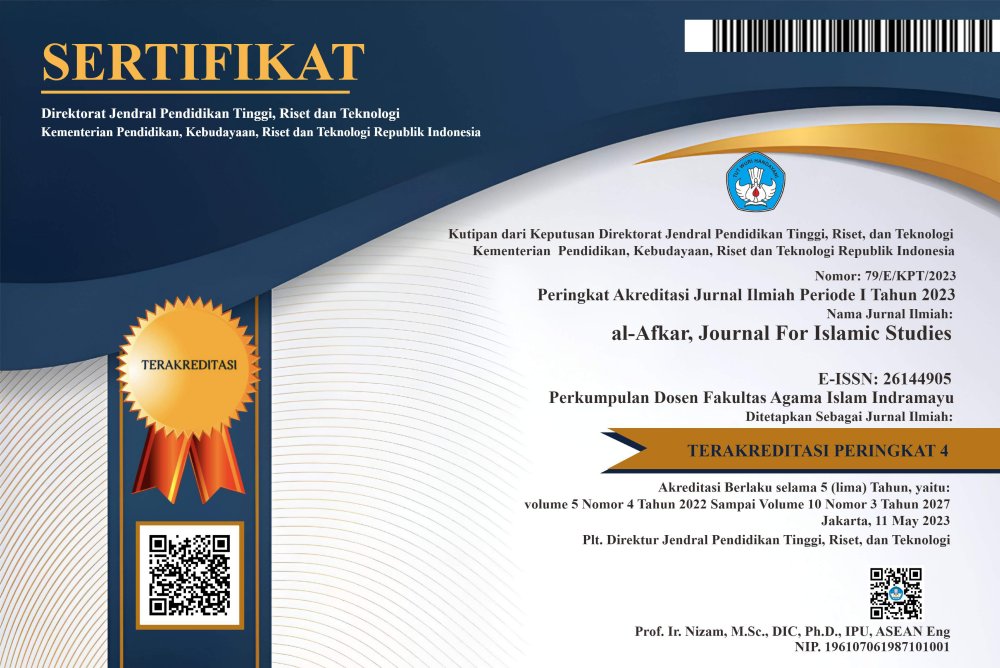Buddhist-Muslim Understanding on Protection of Life Through the Concepts of Buddhist Pāṇātipāta and Islamic Hifz al-Nafs: A Textual Analysis
DOI:
https://doi.org/10.31943/afkarjournal.v7i3.1341Keywords:
Buddhist Muslim Understanding, Protection of Life, Pāṇātipāta, Pancasila, Hifz al-Nafs, Maqasid al-ShariaAbstract
The academic study of the relationship between religion and the protection of life is inevitable hence most intolerance incidents occur in the name of religion or for the religion. In general, religions are concerned with human well-being whether they are followers of that religion or not. Although Buddhism and Islam contain detailed explanations of the protection of life uniquely, the meetings of Buddhists and Muslims are most often portrayed as violent confrontations in the Modern world. So, the objective of this paper is to analyze the concept of protection of life through the ideas of Pāṇātipāta from Buddhism and Hifz al-Nafs from Islam for interreligious understanding between Buddhists and Muslims. This research applies library-based qualitative methodology, in which the researchers use data that includes textual analysis of written materials such as books, journal articles, and internet sources. The findings disclose that although Buddhism and Islam differ fundamentally, both religions share a similar scope for the protection of life which prioritize humanity as the major measure. Hopefully, this study will be able to show that these two ideas are significant when dealing with religious intolerance make a better understanding among Buddhists and Muslims and pave the way for interreligious dialogue for peace and harmony.
Downloads
References
Auda, Jasser. Maqasid al-Shariah Introductory A Guide. IIIT. 2008. https://doi.org/10.2307/j.ctvkc67c6.5.
“Umayyad Dynasty | Achievements, Capital, & Facts | Britannica.” https://www.britannica.com/topic/Umayyad-dynasty-Islamic-history (March 6, 2021).
Ahamed Sarjoon Razick, Ahmad Sunwari Long, Kamarudin Selleh. 2015. “Relationship between the Sinhalese and the Muslims in Sri Lanka: A Bibliographical Survey.” IOSR Journal Of Humanities And Social Science 20(5): 65–70. www.iosrjournals.org.
Ashath, Mohamed. 2021. “Peaceful Coexistence Through the Concepts of Brahmavihārās of Buddhism and Maqāṣid Al-Sharīʿa of Islam: A Content Analysis.” Analisa: Journal of Social Science and Religion 6(01): 1–16.
Berzin, Alexander. 2008. “Buddhist-Muslim Doctrinal Relations.” Buddhist Attitudes toward Other Religions: 212–236. https://studybuddhism.com/en/advanced-studies/history-culture/buddhism-islam- advanced/buddhist-muslim-doctrinal-relations 1.
Berzin, Alexander. 2010. “Historical Survey of the Buddhist and Muslim Worlds’ Knowledge of Each Other’s Customs and Teachings.” The Muslim World 100(2–3): 187–203.
Burckhardt, Titus. 2008. Introduction To Sufi Doctrine.
Carmelo, Monte et al. 2004. “THERAVĀDA AND CARMELITE ASCETICISM.” In , 141–55.
Carus, Paul. 1894. “BUDDHISM AND CHRISTIANITY. EXPOSITION.” oxford journals 5(1): 65–103.
Dhammapada. Taipei: The Corporate Body of the Buddha Educational Foundation, 2013.
Elverskog, Johan (Kristian Petersen). 2010. “Buddhism and Islam on the Silk Road.” Buddhism and Islam on the Silk Road (Book Review) 6410: 1–340.
Elverskog, Johan (Yang Bin). 2010. “Buddhism and Islam on the Silk Road.” Buddhism and Islam on the Silk Road (Book Review) 95: 1–340.
Elverskog, Johan. 2010. University of pennsylvania Press Buddhism and Islam on the Silk Road. Philadelphia, Pennsylvania.
Frydenlund, Iselin, and Michael Jerryson, eds. 2020. Buddhist-Muslim Relations in a Theravada World Buddhist-Muslim Relations in a Theravada World. Palgrave Macmillan.
Frydenlund, Iselin. 2018. “Buddhist Islamophobia: Actors, Tropes, Contexts.” In Handbook of Conspiracy Theory and Contemporary Religion, eds. Asbjørn Dyrendal, David G. Robertson, and Egil Asprem. , 279–302.
Giles Fraser. 2015. “It’s Not the Religion That Creates Terrorists, It’s the Politics.” The Guardian. https://www.theguardian.com/commentisfree/belief/2015/jun/27/its-not-the-religion-that-creates-terrorists-its-the-politics (March 7, 2021).
Golam Dastagir, and Mohammad Ismath Ramzy. 2013. “UNDERSTANDING ‘THE OTHERS:’ BUDDHIST-ISLAMIC DIALOGUE FOR PEACE WITH PARTICULAR REFERENCE TO ‘MODERATION.’” Journal of Chemical Information and Modeling 53(9): 1689–99.
Gravers, Mikael. 2015. “Anti-Muslim Buddhist Nationalism in Burma and Sri Lanka: Religious Violence and Globalized Imaginaries of Endangered Identities.” Contemporary Buddhism 16(1): 1–27. https://www.tandfonline.com/doi/abs/10.1080/14639947.2015.1008090 (March 7, 2021).
Hassan, Farooq. 2012. “A Comparative Approach to Common Ground between Buddhism and Islam.” European Journal of Scientific Research 71(4): 514–19.
Hassan, Farooq. 2012. “Islam and Buddhism in Past and Present as a Path to Peace in Asia.” European Journal of Scientific Research 71(4): 477–81.
Honda, Masataka. 2016. “WORKPLACE INTERACTION AMONG THE SINHALESE (BUDDHISTS) AND THE MUSLIMS IN SRI LANKA.” Kazoku syakaigaku kenkyu 28(2): 250–250.
Hosein, Imran Nazar. Islam and Buddhsim In The Modern World. Sinapore: Centre For Research and Training in Dawah Methodology (CRTMD).
Ibrahim, Haslina et al. 2013. “The Role of Comparative Religion Curricula in Intra-Inter Civilizational Dialogue.” Religious Education 108(1): 28–40.
Jarhom, Sheikha Saidah Binte Mohamad Najeeb. 2014. 11 “REINCARNATION IN BUDDHISM: AN ANALYSIS FROM ISLAMIC PERSPECTIVE.” University of Malaya.
Jordan Elizabeth Diane. 2000. “AN ANALYSIS FREE-WILL AND WITHIN EVALUATION BUDDHIST OF AND TRADITIONS.” Brunel University.
Kazemi, Reza Shah. 2010. Common Ground Between Islam and Buddhism. Jordan: The Royal Aal-Bayt Institute for Islamic Thought.
Khareng, Mutsalim et al. 2014. “Freedom of Religion in Islam and Buddhism: A Comparison Study of the Barriers That Determines the Freedom of Religion.” Asian Social Science 10(22): 315–21.
Knitter, Paul. 2020. “Yoga, Meditation, and Mysticism: Contemplative Universals and Meditative Landmarks by Kenneth Rose.” Journal of Ecumenical Studies 55(1): 135–36.
Liu, Xinru. 2011. “A Silk Road Legacy: The Spread of Buddhism and Islam.” Journal of World History 22(1): 55–81.
Methodology, The et al. 2014. “The Methodology of Religious Studies in Islamic Thought (Arabic).” 2(2).
Novak, Philip. 2017. “Building a Bridge Between Theravada Buddhism and Islam.”
Obuse, Kieko. 2015. “Finding God in Buddhism: A New Trend in Contemporary Buddhist Approaches to Islam.” Numen 62(4): 408–30.
Ramli, Ahmad Faizuddin, Jaffary Awang, and Zaizul Ab Rahman. 2018. “Muslim Scholar’s Discourse on Buddhism : A Literature on Buddha’s Position.” SHS Web of Conferences 53, 04001.
Ramli, Ahmad Faizuddin, Jaffary Awang, and Zaizul Ab Rahman. 2020. “The Contribution of Muslim-Buddhist Relation on Islamic Civilization.” Journal of Islamic Social Sciences and Humanities 22(2): 34–46.
Razick, Ahamed Sarjoon, Ahmad Sunawari Long, and Kamarudin Salleh. 2015. “A Study on Religious Interaction among the Sinhala-Buddhists and the Muslims in Sri Lanka.” International Letters of Social and Humanistic Sciences 53: 133–37.
Relations, L E S et al. 2018. “Relations between the Hindus and the Muslims in the Subcontinent of India and Pakistan / Stable URL : Http://Www.Jstor.Org/Stable/41230004 Relations between the Hindus and the Muslims in the Subcontinent of India and Pakistan.” 5(1): 43–53.
Robert E. Buswell Jr, and Donald S. Lopez Jr., eds. 2013. “The Princeton Dictionary of Buddhism.” https://books.google.com.my/books?id=DXN2AAAAQBAJ&redir_esc=y (March 5, 2021).
Sarjoon, Athambawa. 2019. “Muslims in Maintaining National Integration and Social Harmony in Sri Lanka : From Ancient Rulers to Post-Civil War Context NgZtjpy ; K ]; Ypk ; Fs ;: RNjrpa Kd ; Duhl ; Rpf ; Fhyk ; Kjy ; Rptpy ; Aj ; Jj ; Jf ; Fg ; Gpd ; Duhd Fhyk ; Tiu.” (November).
Sayyid Muhammad Yusuf. 1955. “The Early Contacts Between Islam and Buddhism.” University of Ceylon Review XIII(1): 1–28.
Schmidt-Leukel, Perry. 2010. “Buddhist-Muslim Dialogue. Observations and Suggestions from a Christian Perspective.” Muslim World 100(2–3): 349–63.
Scott, David. 1995. “Buddhism and Islam : Past to Present Encounters and Interfaith Lessons.” Brill 42: 141–55.
Selim, Mohammed. 2011. “The Premises and Promises of the Buddhist-Muslim Dialogue.” Journal of Oriental Studies 21(I): 178–88.
Stewart, James John. 2014. “Muslim–Buddhist Conflict in Contemporary Sri Lanka.” South Asia Research 34(3): 241–60.
Vedas, The Holy. “Comparison between Hinduism and Islam According to the Sacred Scriptures of Both Religions :”
Veljacic-Akpınar, Snježana. 2015. “Buddhist Meditations on Islamic Contemplative Paths: Less Traveled Roads and Abandoned Junctions.” Buddhist Text Translation Society. https://www.amazon.com/Buddhist-Meditations-Islamic-Contemplative-Paths/dp/1601030614 (March 8, 2021).
Yusuf, Imtiyaz. 2006. “Dialogue between Islam and Buddhism through the Concepts of Tathagata and Nur Muhammadi.” International Journal of Buddhist Thought and Culture 5(February 2005).
YUSUF, Imtiyaz. 2009. “Dialogue Between Islam and Buddhism through the Concepts Ummatan Wasatan (The Middle Nation) and Majjhima-Patipada (The Middle Way).” Islamic studies 48(3): 367–94.
Yusuf, Imtiyaz. 2010. “Islam and Buddhism Relations from Balkh to Bangkok and Tokyo.” Muslim World 100(2–3): 177–86.
Yusuf, Imtiyaz. 2015. “Muslim-Buddhist Relations Caught between Nalanda and Pattani.” Ethnicity and Conflict in Buddhist Societies in South and Southeast Asia: 157–270.
Yusuf, Imtiyaz. 2017. “Celebrating Muhammad ’ s Birthday in Buddha ’ s Land : Managing Religious Relations Through Religious Festival.” (April).
Yusuf, Imtiyaz. 2017. “Nationalist Ethnicities as Religious Identities: Islam, Buddhism, and Citizenship in Myanmar.” The American Journal of Islamic Social Sciences 34(4): 100–119.
Downloads
Published
How to Cite
Issue
Section
License
Copyright (c) 2024 Mohamed Ashath, Fathuma Afra, Nur Suriya Binti Mohd Nor

This work is licensed under a Creative Commons Attribution 4.0 International License.



















